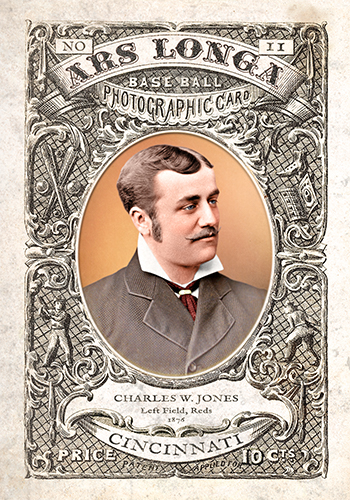- Series: Mort's Reserve
- City: Cincinnati
- Team: Reds (NL)
- League: National League
Charles Wesley Jones (1852-1911) was a star slugger in the NL and AA from 1875-88. Though he never led his teams to pennants, Jones held many early HR records, notably with Boston and Cincinnati. A victim of the Blacklist, Jones lost two seasons in his prime. Despite this, he was the career HR leader thru 1884.
- Was the first player to hit 2 HRs in same inning, 6/10/80. The pitcher was Tom Poorman
- Nickname: Baby
- Birth name: Benjamin Wesley Rippay
- Was the 274th player to debut in MLB
- Was an MLB umpire, 1890-1891
- According to Jay Jaffe's JAWS system, Charley ranks as the 80th best left fielder in MLB history, between Larry Hisle & Joe Rudi
- Until 2012 Jones was the best-known MLB player for whom death info was unknown. The “mystery” was solved by SABR researcher Greg Perkins.
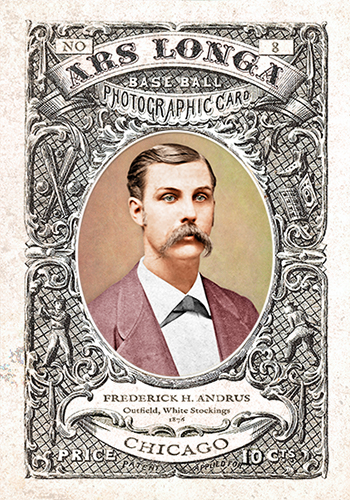
- Series: Mort's Reserve
- City: Chicago
- Team: White Stockings
- League: National League
Frederick Hotham Andrus (1850-1937) had the distinction of making major league baseball a part time occupation. Fred always held gainful employment but stayed close enough to the game to get two opportunities to play at the pinnacle of the sport, both with Chicago. His first brief tour was in 1876 where he played outfield in eight games for the champion White Stockings in the National League's inaugural season. He made a good record, hitting .306 in 36 plate appearances with three doubles and two RBI. Eight years later Andrus returned for a single game for the White Stockings, this time as a pitcher. He completed his start while yielding three runs, two earned, for a “career” ERA of 2.00. Andrus is known to have played for only one official minor league club, Milwaukee of the League Alliance, in 1877. He was one of two managers for the team that year along with Pidgey Morgan. Milwaukee was one of 29 teams vying in the agglomeration known as the League Alliance. It had formed in response to a perceived threat by a rival professional organization, the International Association of Professional Base Ball Players challenging William Hulbert's new National League. Spalding had managed Andrus at Chicago in '76 and was heavily involved with Hulbert in navigating the tumult as the nascent NL established itself as THE major league. In fact, Spalding had founded his famed sporting goods company in 1876, a franchise Andrus would serve as treasurer for eight years beginning with his move to Chicago in 1884. Undoubtedly, it was the high-level connections Andrus had forged in baseball and in business that gave him the entree for his cameo appearance that year back with his old Windy City team.
- Andrus had started out in his native Michigan playing for the Mutuals of Jackson, possibly a successor to one of the earliest organized clubs in America. The Daybreak Club of Jackson had begun in 1860. Jackson had another claim to fame as, in 1854, a meeting “Under the Oaks” just outside of town was the site of the founding of the Republican Party
- Fred left Spalding's company to manage a Detroit real estate concern with which he was still employed at his death from pneumonia at age 87
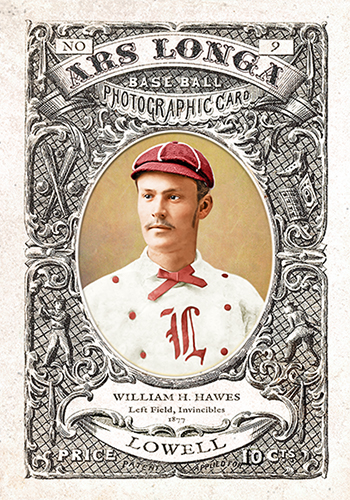
- Series: Mort's Reserve
- City: Lowell
- Team: Invincibles
- League: League Alliance
William Hildreth Hawes (1853-1940) was an infielder out of New England who had a chance to play briefly for Harry Wright in the early days of the National League, first in an 1876 exhibition match in Boston while Bill was with the Lowell club, followed by a stint with Wright’s Red Caps in 1879. It appears he made an impression during that early game that prompted Wright to give Hawes a shot in the outfield. The ‘76 game definitely made an impression on Hawes and his family as, many years later at the end of his long life, Hawes’ obituary included reference to that long ago contest, per the Lowell Evening Leader: “He played second base in Boston when the first professional game was played there in 1876.” Despite his New England roots, Hawes’ passion for baseball took him out west in 1883 when he and many fellow players joined the first recognized minor league, the Northwestern League. Bill signed with Saginaw that year and got his one other opportunity at the big leagues with the Union Association’s Cincinnati Outlaw Reds in ‘84. When the UA collapsed that season, Hawes returned home with Brockton in the new New England League. His team made it to a play-off with Lawrence that inaugural year but Lawrence prevailed in a best-of-three. The prairie beckoned once more and Hawes moved to the Twin Cities, with Minneapolis in 1887-88 and St. Paul for 1889-90. Once again Bill headed home after the 1890 season and went into business in Lowell. He continued to play occasionally with his pals in local leagues and was part of numerous reunions of the Bartlett Club of Lowell, his original squad from 1874-75.
- Hawes served as treasurer of the “Junior Baseball Players of Massachusetts 1873, 1874, and 1875 Association”
- Hawes overcame a weak stint at the plate for Wright’s Boston club where he hit a mere .200 by feasting a bit on Union Association pitching. He managed .278 with the Outlaws giving him an overall .254 average in the major leagues
- Hawes is represented fairly well in Goodwin's Old Judge series with six known poses of him suited up with the Minneapolis Millers in 1888. Although OJ cards exist with his name Hawes properly spelled, it appears that his name was misspelled as "Howes" on his cards more often than not.
- Hawes also appears on the 1879 Boston Red Caps' team composite cabinet, beside teammates Tommy Bond, Ezra Sutton, John Morrill, Jack Burdock and Harry Wright.
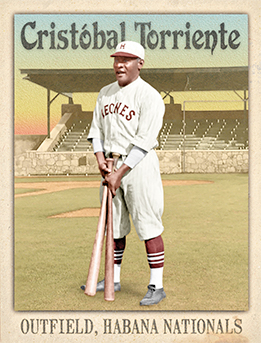
- Series: Diamond Heads '15
- City: Havana
- Team: Leones
- League: Cuban National League
- Hall: Cuban Baseball Hall of Fame, National Baseball Hall of Fame
Cristobal Torriente (1893-1938) had the Babe Ruth build (stocky with spindly, slightly bowed legs) and, more than that, he had a Ruthian swat. He punched his ticket to the Hall of Fame by starring in Cuba and America’s Negro Leagues. In 1920 he was dubbed the “Black Babe Ruth” during an off-season exhibition against Torriente’s Almendares club versus the New York Giants who brought the Babe along. Per his Cooperstown plaque, Cristobal outhit and out-homered the Sultan of Swat over the nine game series, earning a nickname for the ages. Like the best Cuban players, Torriente had been playing at home and in the States for black franchises since 1913. He soon caught the attention of J. L. Wilkinson who signed him for the “All Nations” squad for several years. He helped lead the Chicago American Giants to the first three pennants in the Negro League. The left-handed batter (the Ruth parallels just kept coming) not only hit for power but was often around .400. Fleet of foot (sorry Babe) Torriente was a marvel in the outfield despite his physique and he had a great arm. A rival manager, C.I. Taylor, once remarked “If I see Torriente walking up the other side of the street, I would say, ‘There walks a ballclub.’” He averaged .344 over a long career in black baseball and set the Cuban Winter Leagues record at .350 overall.
- Sadly there was another way in which Torriente patterned himself after Ruth. He loved the nightlife and frequently over-indulged which led to fights with umpires and management. His alcoholism took a dire toll, plunging the slugger into poverty where he fell victim to tuberculosis and an all-too-early death at 44
- The Cuban Hall of Fame was inaugurated a few weeks after Cooperstown’s. Torriente was among the initial class of ten in 1939
- Elected to Hall of Fame: 2006
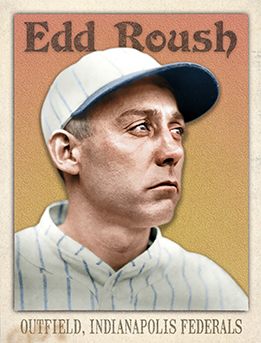
- Series: Diamond Heads '15
- City: Indianapolis
- Team: Hoosiers (FL)
- League: Federal League
- Hall: National Baseball Hall of Fame
Edd J. Roush (1893-1988) was an Indiana farm boy who knew his own mind. He built a Hall of Fame career on doing things his way. Spring training? Not for Edd, he stayed in shape. Use a bat heavier than any other player? Why not? His farm-bred arm strength allowed him to hit the ball wherever he chose with the weight of the bat doing most of the work. Stand still in the box awaiting the pitch? Not for Edd. He'd move his feet after the ball left the pitcher's hand, positioning himself according to his read. Endure management's miserly ways? No, Edd would hold out every year for a fairer contract. He'd skip to pirate leagues (the Federals) if necessary to find a better salary, something he had done as a school-boy player in Hoosier country and continued throughout his long and storied major league tenure. It took a few years in the bigs and a curious impatience by renowned manager John McGraw to get Edd to Cincinnati and the stage on which he would set records. Twice he edged out Rogers Hornsby for batting titles. He led the Reds to the Series championship in 1919, only to have that accomplishment tarnished by scandal. There is little doubt he was right in asserting that his club was better than Chicago's and really won it fair and square. During his twelve years with the Reds, Roush's batting average was .331. He never struck out more than 25 times in a season. He was fast on the bases and a terror in center, regarded as perhaps the premier defender of the Dead Ball era with Tris Speaker the competition.
- McGraw sent young Edd from the Giants to Cincy in 1916 along with two other future Hall-of-Famers: Bill McKechnie and Christy Mathewson. Matty was tickled to get a manager position and Edd and Bill were thrilled to get out from under the tough taskmaster McGraw
- When Edd threw out the ball at the last game played at Crosley Field, Joe Morgan said Roush was “the best of us all.”
- Elected to Hall of Fame: 1962
